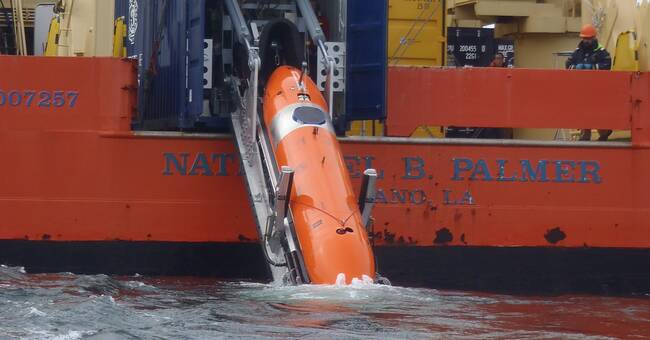- There is currently too much ice to get into Thwaites.
This year it is unusually thick ice, it is probably related to the fact that there has been so much iceberg and parts of the glacier that have come loose.
When it melts, layers of fresh water form that easily freeze, writes oceanographer Anna Wåhlin in an email sent via satellite.
Robots will check under the glacier
The goal is to try to understand how the climate affects Antarctica's giant glaciers that flow into the sea, the so-called shelf icebergs.
The Swedish underwater robot Ran was the first in the world to dive under the Thwaites Glacier at an earlier expedition in 2019, and was then able to map parts of the bottom and measure how warmer water causes the glacier to melt.
Now both Ran and the British underwater robot Boaty McBoatface (which got its name through an internet poll in 2016) will make new dives to measure currents, temperature and salinity and map the ice from below with new sensors.
- We will go further into the glacier with Ran and we also hope to get to a couple of places that we did not reach by 2019. We hope to get information about the large meltdown that we measured in 2019 has continued, writes Anna Wåhlin.
Thwaite's glacier is as large as half of Sweden and contains enough water to raise the sea level more than half a meter.
Melting the entire West Antarctic, sea level rises three meters.
Photo: SVT
Can raise sea level
Thwaite's glacier is called the “Doomsday Glacier” because it contains enough ice to raise sea level 65 centimeters in the very long run if it melts.
The researchers fear that increasingly warmer seawater is now undermining the glaciers, which then "lose their footing" and risk breaking up and flowing into the sea.
- A large part of the ice shelf has begun to collapse.
From satellite images, you could see in the autumn how a series of cracks began to widen and large icebergs broke loose at a very fast pace - quite dramatic changes.
It will be interesting to see how it has changed even below the surface, writes Anna Wåhlin and continues:
- That the floating part of the glacier is collapsing seems quite probable.
Whether these changes are temporary or part of a slow process for this floating glacier to completely disappear, we do not yet know, nor what will happen to the ice on land afterwards.
There are models that indicate that the ice on land may go out to sea at a faster rate, which in that case would lead to an increase in water level.
But the models are very uncertain.
Javascript is disabled
Javascript must be turned on to play video
Read more about browser support
The browser is not supported
SVT does not support playback in your browser.
We therefore recommend that you switch to a different browser.
Read more about browser support
If the Thwaites Glacier collapses, it would lead to rising sea levels.
Photo: EVN

